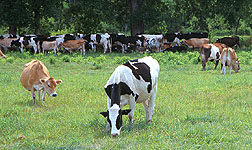This page has been archived and is being provided for reference purposes only. The page is no longer being updated, and therefore, links on the page may be invalid.
Is the Grass Really Greener? Researchers Aim to Find Out
By Jan Suszkiw
October 8, 1999
Exploring the economic and environmental merits of grazing dairy cattle on managed pasture, rather than confining them to indoor feed regimens, is the focus of a cooperative project involving U.S. Department of Agriculture scientists, university colleagues, and the American Farmland Trust (AFT), a farmland conservation group.
Now in its second year, the Cove Mountain Farm Project is named after the mountain that looms above a 300-acre dairy farm owned by AFT and located in south-central Pennsylvania. A small army of researchers besieges the farm each week to monitor a slew of instruments there, including stream gauges for recording nutrient losses from pasture where 150 Holstein and jersey cows graze.
Popularized in New Zealand and Europe, grass-based systems call for grazing small herds of cattle on intensively managed pastures. In the U.S., large dairy operators traditionally confine their herds--of 1,000 animals or more--to feed regimens of hay, grain, or cut forage like alfalfa.
Some estimates indicate that grazing-based systems on small- to medium-sized dairies can boost net incomes by $50 to 100 per cow annually. While full confinement operations produce higher milk yields, grazing-based farms profit by reducing operating and labor costs associated with growing, harvesting, and storing crops like corn as year-round feed. Another benefit is the reduced capital investment needed to house and manage large herds.
Still unknown, though, is intensive grazing's impact on the health, productivity, competitiveness and distribution of these pasture plants, according to Bill Stout, a lead researcher and soil scientist with ARS' Pasture Systems and Watershed Management Research Lab at University Park, Pennsylvania.
Stout's chief focus is determining the extent to which urine and feces from grazing animals contribute to nitrate leaching or phosphorous runoff.
A more detailed article about the Cove Mountain Farm Project is in the October issue ofAgricultural Research, the ARS' monthly magazine. The story also appears on the Web at:
/is/AR/archive/oct99/dairy1099.htm
Scientific contact: William Stout, ARS Pasture Systems and Watershed Management Research Laboratory, University Park, Pa., phone (814) 863-0947, fax (814) 863-0935, ws1@psu.edu.

